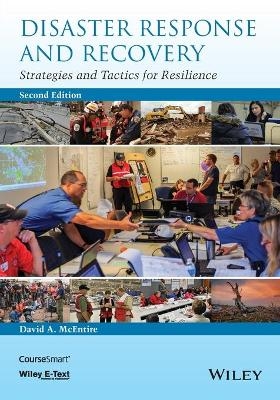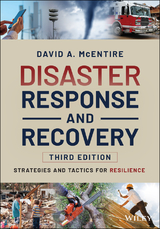
Disaster Response and Recovery
John Wiley & Sons Inc (Verlag)
978-1-118-67302-7 (ISBN)
- Titel ist leider vergriffen;
- Artikel merken
* Includes updated chapters keeping the material fresh and accessible while incorporating recent changes in policy and new research
* Highlights lessons learned from such incidents and catastrophes as: Hurricane Katrina, Earthquake in Haiti, Parking lot collapse in Miami, West Texas industrial explosion, Train wreck in Spain, Aurora movie shooting, Times Square bombing, etc.
* Examines typical challenges to be expected during response efforts along with tools and techniques to enhance the ability to protect lives, reduce property damage and minimize disruption
* Includes an instructor package which contains: Sample Syllabus, Teaching Suggestions, Test bank, and PowerPoints
David McEntire is a Professor in the Emergency Administration and Planning Program (EADP) in the Department of Public Administration at the University of North Texas. He teaches emergency management courses in both the undergraduate and graduate programs. Dr. McEntire has written extensively on emergency management and has been recognized by peers as the recipient of the Blanchard Award for Academic Excellence in Emergency Management Higher Education.
About the Author xiv
Foreword xvi
Preface xviii
Acknowledgments xxi
1. Knowing What to Expect 1
1.1 The Occurrence of Disasters 2
1.1.1 Important Concepts 3
1.1.2 Preview of Disaster Response and Recovery 6
1.2 Types of Hazards 7
1.2.1 Natural Hazards 8
1.2.2 Atmospheric Hazards 8
1.2.3 Geological Hazards 13
1.2.4 Hydrologic Hazards 14
1.2.5 Seismic and Volcanic Hazards 16
1.2.6 Wildfire Hazards 19
1.2.7 Biological Hazards 19
1.3 Technological Hazards 20
1.3.1 Industrial Hazards 20
1.3.2 Environmental Hazards 21
1.3.3 Nuclear Hazards 22
1.3.4 Structural Collapse Hazards 22
1.3.5 Computer Hazards 23
1.3.6 Transportation Hazards 24
1.4 Civil/Conflict Hazards 26
1.4.1 Mass Shootings 26
1.4.2 Panic Flight 27
1.4.3 Riots 28
1.4.4 Terrorism 29
1.4.5 War 30
1.5 The Complexity and Impact of Disasters 31
1.5.1 The Nature of Disasters 32
1.5.2 Changes Associated with Disasters 33
1.5.3 The Need for Response and Recovery Operations 34
2. Understanding the Actors 44
2.1 The Public Sector 45
2.1.1 Local Government 45
2.1.2 County and Regional Governments 48
2.1.3 State Government 49
2.1.4 Federal Government 52
2.1.5 Tribal Government 56
2.2 The Private Sector 58
2.2.1 Emergency and Long-Term Medical Care 58
2.2.2 Sheltering and Housing 59
2.2.3 Media Reporting 59
2.2.4 Volunteers and Donations 59
2.2.5 Insurance Settlements 59
2.2.6 Utility Restoration and Community Reconstruction 60
2.2.7 Business Continuity 61
2.2.8 Transportation 61
2.2.9 Vending of Goods and Services 62
2.3 The Nonprofit Sector 62
2.3.1 The Red Cross 63
2.3.2 Faith-Based Organizations 64
2.3.3 Community Groups 65
2.4 Citizen and Emergent Groups 66
2.5 Working with Different Groups and the Whole Community 69
3. Anticipating Human Behavior in Disasters 79
3.1 The Impact of Hollywood and The Media 80
3.1.1 Hollywood 80
3.1.2 The Media 81
3.2 Research on Myths 82
3.3 Evidence of Exaggeration 87
3.4 Realities about Response and Recovery 91
3.5 The Importance of Understanding Behavior Correctly 96
4. Recognizing Alternative Management Approaches 104
4.1 The Traditional Model 105
4.1.1 Features of the Traditional Model 107
4.1.2 Strengths of Traditional Model 109
4.1.3 Weaknesses of Traditional Model 112
4.2 The Professional Model 114
4.2.1 Features of the Professional Model 115
4.2.2 Strengths of the Professional Model 116
4.2.3 Weaknesses of Professional Model 118
4.3 Comparison of The Models 120
5. Implementing Initial Response Measures 127
5.1 Hazard Detection 128
5.1.1 Initial Steps 131
5.2 Issuing Warnings 135
5.2.1 Types of Warning Systems 137
5.2.2 Warning Considerations 140
5.3 Evacuation 142
5.3.1 Means of Evacuation 143
5.3.2 Evacuation Behavior 144
5.3.3 Evacuation Considerations 146
5.3.4 Evacuation Procedures 148
5.4 Sheltering 149
5.4.1 Sheltering Types 150
5.4.2 Shelter Use and Characteristics 151
5.4.3 Working with Others to Establish and Manage Shelters 152
6. Caring for the Injured, Dead, and Distraught 163
6.1 Search and Rescue Operations 164
6.1.1 Types of SAR 164
6.1.2 Human Behavior in SAR Operations 165
6.1.3 Issues to Consider When Carrying Out SAR 166
6.1.4 Professional USAR Teams 168
6.1.5 Conducting SAR Operations 170
6.2 Emergency Medical Care and Triage 173
6.2.1 Treating the Injured 174
6.2.2 Triage 177
6.2.3 Disaster Medical Assistance Teams 179
6.3 Mass Fatality Management 181
6.3.1 Mass Fatality Incidents and Their Challenges 183
6.3.2 Responding to Mass Fatality Incidents 184
6.3.3 Disaster Mortuary Operational Response Teams 186
6.4 Stress Management 189
6.4.1 Vulnerability to PTSD/CIS 189
6.4.2 Common Signs of PTSD/CIS 191
6.4.3 Overcoming PTSD/CIS 191
6.4.4 The Merit of Defusings and Debriefings 194
7. Managing Public Information, Donations, and Volunteers 204
7.1 The Media and Disasters 205
7.1.1 Types of Media 205
7.1.2 Challenges Associated with the Media 207
7.1.3 Strategies for Working with the Media 210
7.2 Dealing with Donations 213
7.2.1 Challenges Resulting from Donations 215
7.2.2 Recommendations for Donations Management 220
7.3 Volunteer Management 223
7.3.1 Difficulties Associated with Volunteers 224
7.3.2 Strategies for Volunteer Management 226
7.3.3 Advantages of Volunteer Management 228
8. Moving Beyond Immediate Needs 236
8.1 Assessing Damages 237
8.1.1 Types of Damage Assessment 239
8.1.2 Methods of Conducting Damage Assessment 240
8.2 Challenges in Damage Assessment 242
8.2.1 Accuracy 242
8.2.2 Working with Others 243
8.2.3 Access and Safety 243
8.3 Damage Assessment Procedures 245
8.3.1 Preassessment Activities 245
8.3.2 Assessment Activities 245
8.4 Disaster Declarations 248
8.4.1 Difficulties Associated with the Process 249
8.4.2 Factors Determining Declarations 250
8.4.3 Other Unique Requirements 251
8.5 Debris Produced by Disasters 252
8.5.1 Types of Debris 252
8.5.2 Debris Management Challenges 255
8.6 Dealing with Debris Effectively 257
8.6.1 Storage Locations and the Environment 258
8.6.2 Epa Recommendations for Improving Debris Management 260
8.7 Regulations and Other Considerations 261
8.7.1 Reducing Expenses 262
8.7.2 Preventing Fraud 262
9. Promoting Recovery and Mitigation 272
9.1 Disaster Impacts and Disaster Assistance 273
9.2 Types of IA 275
9.2.1 Loans and Grants 276
9.2.2 Services 277
9.2.3 Benefits 278
9.3 Obtaining IA 279
9.3.1 National Processing Service Center (NPSC) 279
9.3.2 Disaster Recovery Center (DRC) 280
9.4 Categories of PA 284
9.4.1 Emergency Assistance 284
9.4.2 Permanent Assistance 285
9.5 Obtaining PA 286
9.6 Important Issues for Recovery 288
9.6.1 Minimizing Fraud 289
9.6.2 Protecting the Environment 289
9.6.3 Preserving Historic Buildings 290
9.6.4 Mitigating Future Disasters 291
9.7 The Potential for Disagreement 296
9.8 Pressing for Change 297
9.8.1 Lessons from the Loma Prieta Earthquake 298
10. Overcoming Typical Challenges 307
10.1 Communications and Coordination 308
10.1.1 The Importance of Communication and Coordination 309
10.1.2 Communication and Coordination Barriers 309
10.1.3 Enhancing Communication 310
10.1.4 Improving Coordination 311
10.2 Decision Making 313
10.2.1 Overcoming Decision Errors 316
10.3 Transportation Issues and Logistics 317
10.3.1 Dealing with Transportation Problems 318
10.3.2 Logistics in Disasters 319
10.4 Special Populations 320
10.4.1 Gender 322
10.4.2 Race and Ethnic Groups 322
10.4.3 The Poor 324
10.4.4 Tourists 325
10.4.5 The Elderly 325
10.4.6 Children 325
10.4.7 The Disabled 325
10.4.8 Other Special Needs Groups 326
10.4.9 Meeting the Needs of Special Populations 327
10.5 Politics 328
10.5.1 Overcoming Political Problems 329
10.6 Legal Concerns 331
10.6.1 Disasters and Law 331
10.6.2 Constitutional Rights 333
10.6.3 Negligence 333
10.6.4 Minimizing Liability 334
10.7 Record Keeping 335
10.7.1 Record Keeping Problems 336
10.7.2 Keeping Accurate Records 337
11. Harnessing Technology and Organization 348
11.1 The Importance of Technology 349
11.2 Communication Equipment and Interoperability 351
11.2.1 Trunked Radio Systems 352
11.2.2 The Internet 353
11.2.3 Voice over Internet Protocol and Other Equipment 353
11.2.4 The ACU-1000 353
11.2.5 Interoperability 354
11.3 Decision Support Systems (DSSs) 354
11.4 GIS 357
11.5 Managing Disasters at the Local Level 359
11.5.1 ICS 359
11.5.2 Principles of Incident Command 360
11.5.3 Strengths and Weaknesses of Incident Command 363
11.5.4 EOC 365
11.5.5 Characteristics of an EOC 365
11.5.6 Challenges Facing EOCs 367
11.5.7 Using EOCs 368
11.5.8 Comparison of ICS and EOCs 368
11.5.9 Memorandums of Understanding and Mutual Aid Agreements 369
11.6 Managing Disasters at the State Level 370
11.6.1 SEMS 370
11.6.2 EMAC 371
11.7 Managing Disasters on a Federal Level 373
11.7.1 NIMS 373
11.7.2 Goals of NIMS 374
11.7.3 Principles of NIMS 375
11.7.4 Strengths and Weaknesses of NIMS 377
11.7.5 NRF 378
11.7.6 ESFs in the NRF 379
11.7.7 The National Disaster Recovery Framework 382
11.7.8 Recovery Support Functions in the NDRF 384
12. Foreseeing the Future 394
12.1 Disasters on the Rise 395
12.2 Understanding Natural Disasters398
12.2.1 Responding to a Natural Disaster 399
12.3 Understanding Technological Disasters 405
12.3.1 Responding to HazMat Incidents 406
12.4 Understanding Acts of Violence 409
12.4.1 Responding to Acts of Violence 409
12.5 Understanding Terrorism 412
12.5.1 Responding to Terrorist Disasters 413
12.5.2 Protecting First Responders 416
12.5.3 Protecting Evidence 417
12.5.4 Relying on Other Organizations 418
12.6 Insufficiently Recognized Hazards 421
12.6.1 Environmental Degradation, Global Warning, and Climate Change 421
12.6.2 Pole Reversals 423
12.6.3 Asteroid Strikes 424
12.6.4 Biological Threats 426
12.6.5 Computer/Information Technology Hazards 430
12.6.6 Responding to Computer/Information Technology Disasters 431
12.7 Increased Vulnerability 432
12.7.1 Persistent Poverty 433
12.7.2 Growing Population and Urbanization 433
12.7.3 Increased Diversity 434
12.7.4 Further Industrialization 434
12.7.5 Internationalization 435
12.7.6 Improper Land Use and Construction 436
12.7.7 Weak Emergency Management Institutions 436
12.7.8 Other Factors 437
13. Enhancing Disaster Resilience 450
13.1 Preparing Your Community 451
13.1.1 Creating an Ordinance 452
13.1.2 Establishing a Preparedness Council 452
13.2 Acquiring Financial Resources 455
13.2.1 Resource Lists 455
13.2.2 Annual Budgets 455
13.2.3 Grants 456
13.2.4 Applying for and Managing Grants 457
13.3 Establishing an EOC 458
13.4 Hazard and Vulnerability Assessment 460
13.5 Writing an EOP 461
13.6 First Responder and Organizational Training 463
13.7 Disaster Exercises 464
13.7.1 Types of Exercises 464
13.7.2 Managing Exercises 465
13.7.3 Exercise Participants and Other Considerations 466
13.8 Public Education 467
13.9 Spontaneous Planning, Improvisation, Creativity, and Flexibility 469
13.10 Leadership and Professionalism 474
13.10.1 Becoming a Professional Emergency Manager 476
Bibliography 487
Index 528
| Erscheint lt. Verlag | 9.1.2015 |
|---|---|
| Verlagsort | New York |
| Sprache | englisch |
| Maße | 180 x 257 mm |
| Gewicht | 1088 g |
| Einbandart | kartoniert |
| Themenwelt | Medizin / Pharmazie ► Medizinische Fachgebiete ► Notfallmedizin |
| Studium ► Querschnittsbereiche ► Prävention / Gesundheitsförderung | |
| Naturwissenschaften ► Chemie | |
| Recht / Steuern ► Strafrecht ► Kriminologie | |
| Sozialwissenschaften ► Soziologie | |
| Technik | |
| ISBN-10 | 1-118-67302-6 / 1118673026 |
| ISBN-13 | 978-1-118-67302-7 / 9781118673027 |
| Zustand | Neuware |
| Informationen gemäß Produktsicherheitsverordnung (GPSR) | |
| Haben Sie eine Frage zum Produkt? |
aus dem Bereich



